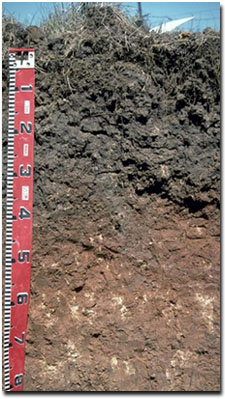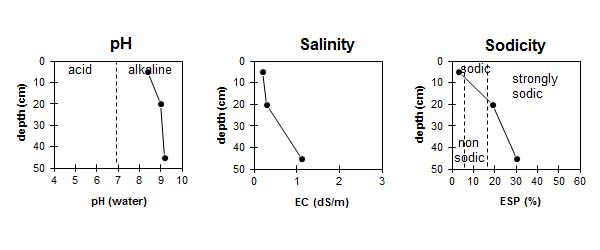Site LS13A
Location: Netherby
Australian Soil Classification: Epicalcareous-Epihypersodic, Self-mulching, Grey VERTOSOL
Northcote Factual Key: Ug 5.2
Great Soil Group: grey clay
General Landscape Description: Low lying area of gently undulating plain.
Site Description: Undisturbed roadside reserve.
Native Vegetation: Black Box (Eucalyptus largiflorens) and Lignum Bush (Muehlenbeckia cunninghamii) is the natural vegetation.

LS13a Landscape
Soil Profile Morphology:
Surface Soil
| A1 | 0-10 cm | Dark yellowish brown (10YR3/3); medium clay; self-mulching; strong fine blocky structure; strong consistence dry; pH 8.4; clear change to: |  LS13A Profile |
| Subsoil | |||
| B21 | 10-30 cm | Dark yellowish brown (10YR4/2); heavy clay; weak coarse prismatic, parting to strong medium blocky structure; very strong consistence dry; contains a few (2-5%) soft carbonate segregations; pH 9.0; clear and wavy change to: | |
| B22 | 30+ cm | Strong brown (7.5YR4/6); medium heavy clay; strong medium subangular blocky structure; strong consistence dry; contains a common (> 20%) amount of soft carbonate; pH 9.2. | |
- Clay texture throughout profile.
- Self-mulching surface soil.
- Occurrence of significant cracking in the soil profile when dry. Cracking often appears at soil surface.
Soil Profile Characteristics:
| - | pH | Salinity | ||
Surface (A1 horizon) | Moderately Alkaline | Low | Non-Sodic | Slaking, No dispersion1 |
Subsoil (B21 horizon) | Strongly Alkaline | Low | Strongly Sodic | None2 |
Deeper Subsoil (at 50 cm) | Strongly Alkaline | High | Strongly Sodic | Strong |

| The surface soil is moderately alkaline. The subsoil is strongly alkaline throughout. | The salinity rating is low in the surface and upper subsoil becoming high with depth. | The surface is non-sodic. The subsoil is strongly sodic. |
Management Considerations:
Surface (A) Horizon
- The surface soil is self-mulching which provides a good seed bed that is friable and easily worked. The surface becomes sticky when wet.
- The surface soil has a high inherent fertility (based on the sum of the exchangeable basic cations).
- Tillage or excessive trafficking should be avoided if the soil is wetter than the plastic limit. Such disturbance may result in soil structural degradation (eg. compaction, smearing) occurring. Ideally, tillage should take place when the soil is drier than the plastic limit down to at least the depth of tillage.
Subsoil (B) Horizons
- The top of the subsoil is strongly sodic but does not disperse (unless mechanically disturbed when moist). It is also strongly alkaline which indicates that certain nutrients may be poorly available to plants (eg. zinc, iron, copper and manganese).
- From 30 cm depth the subsoil is strongly sodic and strongly dispersive which will result in root and water movement being restricted. The level of soluble salts increases in this horizon which will restrict the growth of salt sensitive plants. Few roots were observable below 30 cm depth at the pit face.
Profile Described By: Mark Imhof, John Martin, David Rees, Sonia Thompson (May 1994).


